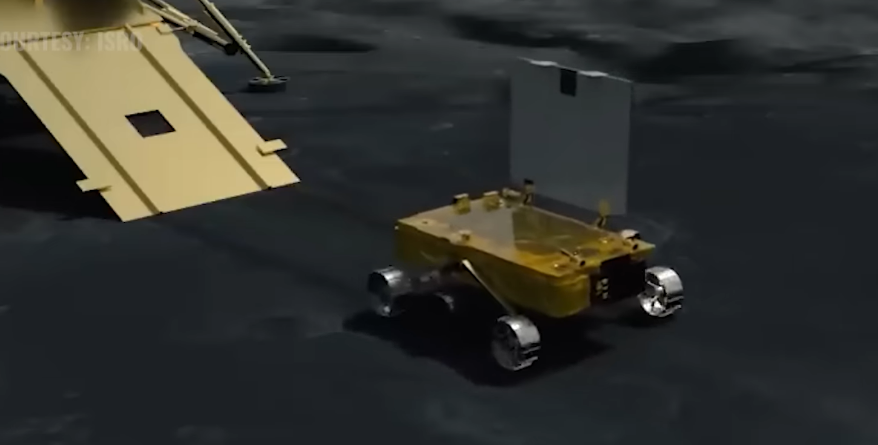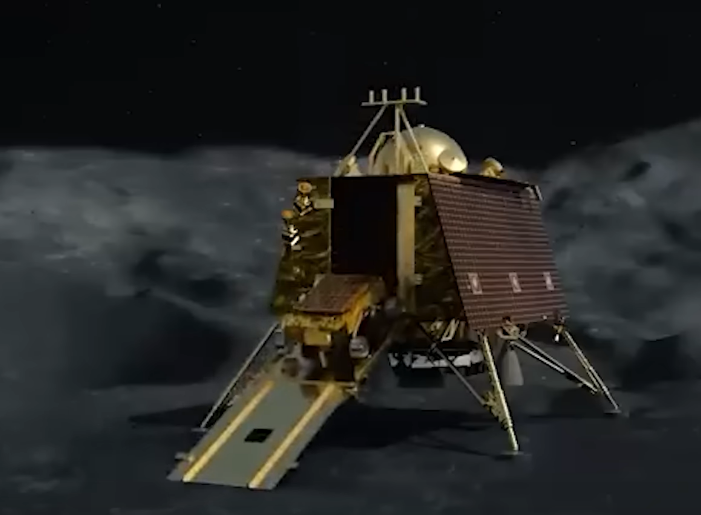India creates history on Wednesday, August 23, 2023, with the landing of its Chandrayaan-3 mission on the moon’s south pole.
The landing is scheduled to take place at 6:04 p.m. IST (10:34 a.m. EDT). The lander, Vikram, will touch down on the surface of the moon near the crater Manzangue Crater. The rover, Pragyan, will then be deployed to explore the surrounding area.
The Chandrayaan-3 mission is a significant milestone in India’s space exploration efforts. The first Chandrayaan mission, which launched in 2008, was a lunar orbiter. The second mission, Chandrayaan-2, launched in 2019, attempted to land a lander and rover on the moon’s south pole, but the lander crashed during the final descent.

Chandrayaan-3 is equipped with a number of scientific instruments that will be used to study the moon’s surface and composition. The instruments will also look for signs of water ice, which could be a resource for future human missions to the moon.
The mission is being led by the Indian Space Research Organisation (ISRO). ISRO is a government agency that is responsible for India’s space program.
The Chandrayaan-3 landing becomes a historic moment for India and for the world. It will be the first time that a country has landed on the moon’s south pole. The mission will also provide valuable data about the moon’s surface and composition, which could help us to better understand the moon and its potential as a resource for future human missions.
How to Watch the Chandrayaan-3 Landing Live
The Chandrayaan-3 landing will be broadcast live on ISRO’s website and YouTube channel. The live stream will begin at 5:30 p.m. IST (9:05 a.m. EDT).
Updates: Live Stream has ended if you have Missed the live stream you can watch it here.
Chandrayaan-3 Status Updates
- India made history today as its Chandrayaan-3 spacecraft successfully soft-landed on the moon’s south pole at 6:04 PM IST.
- The mission is launched on July 14, 2023, from the Satish Dhawan Space Centre in Sriharikota, India. The landing on the moon is scheduled to take place on August 23, 2023.
Chandrayaan-3 Mission:
Updates:The communication link is established between the Ch-3 Lander and MOX-ISTRAC, Bengaluru.
Here are the images from the Lander Horizontal Velocity Camera taken during the descent. #Chandrayaan_3#Ch3 pic.twitter.com/ctjpxZmbom
— ISRO (@isro) August 23, 2023
Achieving success, Chandrayaan-3 position India as the fourth nation to accomplish a lunar landing, following the footsteps of the United States, China, and Russia.
The Intricacies of Chandrayaan 2’s Mission and Its Setback
ISRO, the space agency of India, encountered an unexpected hurdle in its Chandrayaan 2 project caused by technical challenges. This prompted a resilient reaction from the team. After the unexpected setback during the Chandrayaan 2 mission, ISRO worked vigorously to prepare for the imminent launch of Chandrayaan 3. The Indian Space Research Organisation, greatly respected for its extraordinary accomplishments in space exploration, remains resolute and persistent, despite the challenges encountered during the Chandrayaan 2 mission. The focus now shifts towards revitalizing lunar exploration efforts.
Chandrayaan 3: A Fresh Pursuit of Lunar Exploration
ISRO’s Unwavering Resolve for Lunar Exploration Shines Through Chandrayaan 3: ISRO launched Chandrayaan 3 on July 14th from the Satish Dhawan Space Centre in Sriharikota. This event held immense significance in India’s expedition into space. The upcoming venture, Chandrayaan 3, truly showcased India’s unwavering commitment to pushing forward in space exploration, even in the face of the difficulties encountered during Chandrayaan 2.
Chandrayaan 3 Launch video:
Chandrayaan-3’s Multifaceted Objectives
A Triad of Ambitious Objectives Underpinning Chandrayaan-3: The objectives underpinning Chandrayaan-3’s mission encompass a triad of ambitious goals. The first aims to successfully demonstrate a secure and gentle landing on the lunar terrain, marking a significant stride in India’s lunar exploration aspirations. Second on the list is the demonstration of a rover’s mobility across the lunar expanse, showcasing India’s technical prowess in extraterrestrial roving. Finally, Chandrayaan-3 is geared to perform in-situ scientific experiments, elevating India’s contributions to lunar research.
India’s Ascent to Lunar Achievement
Chandrayaan-3’s Triumph: Paving the Way for India’s Lunar Landmark: With the success of Chandrayaan-3, India has solidified its position as the fourth nation to accomplish a triumphant Moon landing, joining the ranks of the United States, China, and Russia. This accomplishment not only signifies India’s prominence in lunar exploration but also showcases its exceptional technical capabilities on the global space stage.
Chandrayaan-3 Mission:
The image captured by the
Landing Imager Camera
after the landing.It shows a portion of Chandrayaan-3’s landing site. Seen also is a leg and its accompanying shadow.
Chandrayaan-3 chose a relatively flat region on the lunar surface 🙂… pic.twitter.com/xi7RVz5UvW
— ISRO (@isro) August 23, 2023
Deciphering Chandrayaan 2’s Missteps
A Closer Look at Chandrayaan 2’s Unintended Hurdles –
Chandrayaan 2, India’s second lunar odyssey, embarked on its journey with great anticipation. However, tragedy struck when ISRO faced an unexpected setback. Launched on July 22, 2019, Chandrayaan 2 faced a heart-wrenching turn of events in September. During its approach to the lunar surface, ISRO encountered a loss of communication with the Vikram lander, responsible for the soft landing.
The Fateful Moments of the Vikram Lander
The Critical Moments of Vikram Lander’s Descent: As the Vikram lander descended, a critical anomaly unfolded. The expected trajectory adjustment of 55 degrees went awry as the lander tilted to a staggering 410 degrees. This unforeseen deviation spelled doom for the soft landing mission. The unfortunate consequence was the abrupt loss of contact with the lander, just a mere 400 meters from the lunar surface.

A Missed Opportunity and Software Glitch
The Missed Lunar Connection and Its Root Cause: The pivotal moments leading to the mission’s downfall were accentuated by the inability to rectify the Vikram lander’s off-kilter trajectory. The anticipated deceleration from 6000 kmph to 0 kmph, occurring in four planned phases, was thwarted as ISRO’s contact with the lander ceased moments before touchdown. ISRO authorities revealed that a software glitch was responsible for the communication breakdown.
Impactful Collision on Lunar Ground
The Unintended Lunar Consequence of Vikram Lander’s Trajectory Shift: Owing to the trajectory deviation and the subsequent failure to slow down as intended, the Vikram lander and its companion, the moon rover Pragyan, endured an impact-filled landing on the Moon’s surface. This unintended and harsh collision marked the conclusion of Chandrayaan 2’s mission, overshadowing its initial aspirations for a successful soft landing.
The driving force behind ISRO’s Chandrayaan-3 mission comprises six prominent scientists:
- Leading the mission is P Veeramuthuvel, who hails from a lineage of former Railway personnel. He assumes the role of Project Director and oversees the comprehensive execution of Chandrayaan-3, fostering seamless collaboration among numerous ISRO centers.
- B N Ramakrishna holds the position of Director at ISTRAC. Situated in Bengaluru, this facility serves as ISRO’s nerve center for managing deep space missions. Ramakrishna, the seventh Director of ISTRAC, is responsible for amalgamating data from deep space network stations.
- Heading the U R Rao Space Centre is M Sankaran, previously recognized as the Isro Satellite Centre. This entity fabricates spacecraft for ISRO’s space ventures. Notably, Chandrayaan-3’s spacecraft was fabricated at URSC under Sankaran’s leadership. Having taken the helm in June 2021, he formerly occupied the post of deputy director for Communication and Power Systems Unit at URSC. His involvement in designing solar arrays, power systems, and communication networks for Isro’s Chandrayaan 1 and 2, along with Mars Orbiter Missions (MOM), is noteworthy.
- Orchestrating the launch of Chandrayaan-3 on July 14 is S Mohana Kumar, the Mission Director. With the LMV3 rocket as the launch vehicle, Isro’s triumph was formally declared by Mohana Kumar on the aforementioned date at Sriharikota.
- The responsibility of devising propulsion systems aboard Chandrayaan-3 rests with V Narayanan, Director of Liquid Propulsion Systems Centre. Narayanan, an authority in propulsion system analysis, cryogenic engine design, and adept management of substantial projects, has actively contributed to the design of propulsion mechanisms integral to Chandrayaan-3.
- A virtuoso in human space flight systems, S Unnikrishnan Nair, leads the Vikram Sarabhai Space Centre—an eminent rocket assembly establishment in Thiruvananthapuram. Nair, who joined ISRO in 1985, has been instrumental in the evolution of diverse aerospace systems and mechanisms for PSLV, GSLV, and LVM3 rockets.

About ISRO
The national space agency of India is the Indian Space Research Organisation, often denoted as ISRO. It functions as the primary body for research and development within the Department of Space (DoS), which the Prime Minister of India directly supervises. The executive head of DoS also concurrently holds the position of ISRO’s Chairman.
ISRO’s core responsibilities encompass conducting activities linked to space operations, exploring outer space, fostering global space collaboration, and advancing associated technologies. Amongst government space agencies globally, only six possess comprehensive launch capabilities, incorporate cryogenic engines, conduct extraterrestrial expeditions, and manage an extensive array of artificial satellites.
Initially known as the Indian National Committee for Space Research (INCOSPAR), established under the guidance of Jawaharlal Nehru in 1962 to address the imperative for space research, it eventually evolved into ISRO in 1969 within the Department of Atomic Energy (DAE). The government of India further instituted a Space Commission and DoS in 1972, thereby bringing ISRO under their purview. This establishment formalized India’s engagement in space research.[5][6] Subsequently, ISRO has operated under the governance of DoS, which also administers various other astronomy and space technology institutions across India.
ISRO pioneered Aryabhata, India’s inaugural satellite, launched by the Soviet space agency Interkosmos in 1975. In 1980, ISRO initiated the RS-1 satellite via the SLV-3, positioning India as the seventh nation capable of orbital launches. ASLV succeeded SLV-3, eventually leading to the creation of several medium-lift launch vehicles, rocket engines, satellite systems, and networks. These advancements enabled ISRO to deploy numerous domestic and international satellites, along with conducting deep space expeditions for cosmic exploration.
ISRO maintains the largest global constellation of remote-sensing satellites, alongside managing satellite navigation systems like GAGAN and IRNSS (NavIC). It has executed three lunar missions and a Mars expedition.
ISRO’s immediate objectives encompass enlarging the satellite fleet, executing lunar rover landings, conducting crewed spaceflight, developing semi-cryogenic engines, performing additional unmanned lunar, Martian, Venusian, and solar missions, and deploying additional space observatories to study cosmic phenomena and interstellar space beyond the solar system. On a longer timeline, ISRO intends to fabricate reusable launch systems, heavy and super heavy-lift vehicles, establish a space station, launch exploration missions to planets such as Jupiter, Uranus, Neptune, and asteroids, and execute human missions to moons and planets.
ISRO’s initiatives have significantly contributed to India’s socio-economic progress, supporting civil and military sectors in various capacities including disaster management, telemedicine, navigation, and reconnaissance missions. Furthermore, ISRO’s spin-off technologies have spawned crucial innovations within India’s engineering and medical sectors.
Congratulations to India on the successful launch of #Chandrayaan3🚀! We are over the moon🌒 about @ISRO’s incredible achievements in the space. Exciting times for international space exploration as we continue #USIndiaSpace collaboration. Chandrayaan-3 data holds immense… pic.twitter.com/gmHe7M7nYZ
— U.S. Embassy India (@USAndIndia) July 14, 2023
The Chandrayaan-3 mission is a significant milestone in India’s space exploration efforts. India becomes the first country to land on the moon’s south pole, and it will also provide valuable data about the moon’s surface and composition.The moment that unfolded on August 23, 2023, created history and was broadcasted live on ISRO’s website and YouTube channel.
For More information, visit ISRO Official website
For latest News & Updates Follow Roshbytes and Press the bell icon on the right to subscribe to our notifications.




